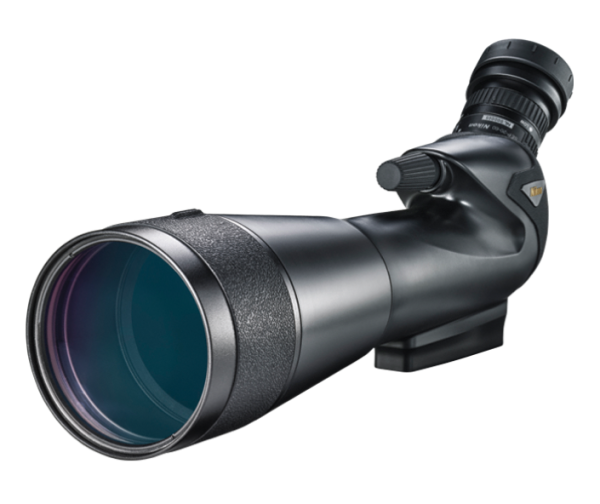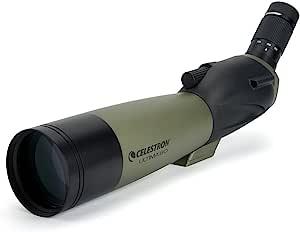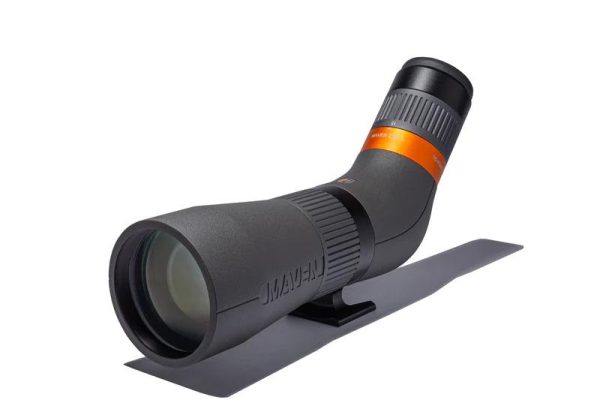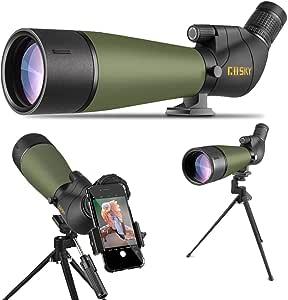Spotting scopes are long-range, high-powered telescopes built for day use, allowing you to see far-away objects in great detail. As an integral tool in many outdoor pursuits, understanding the best models to buy is important to hunters, birdwatchers, photographers, campers, and even stargazers. If you can relate, you’re in the right place.
In the following sections, we’ll tell you everything you need to know about purchasing spotting scopes, divulge the top five models, and even provide a comparison table to help you make an informed decision with ease.
What Is a Spotting Scope?
A spotting scope is a monocular telescope of varying magnifications used to see far away land bound objects (usually animals) in great detail, color, and brightness. The small, portable telescope is versatile and a favorite among many outdoor enthusiasts for its lightweight yet rugged build.
Although it’s very similar to a pair of binoculars or a telescope, it’s not the same thing, as we’ll explain below.
Spotting Scopes VS Binoculars VS Telescopes
Spotting scopes are easy to transport and have outstanding magnification capabilities. However, they’re considered more cumbersome than binoculars, and they typically need to be used with a tripod to garner the best visuals.
Binoculars, on the other hand, are easiest to transport and come in a range of sizes, but their magnification capabilities don’t come anywhere near that of spotting scopes. As the name suggests, they also have two lenses (spotting scopes have one), allowing viewers to utilize both eyes and reduce fatigue.
Unlike spotting scopes and binoculars, telescopes are purpose-built for nighttime viewing of elements in the sky, like the moon, stars, and planets. They’re often much larger than spotting scopes and harder to carry around.
6 Factors to Consider When Buying a Spotting Scope
Purchasing a spotting scope requires careful consideration of the following six factors
#1 Magnification Spotting scope’s magnification power typically runs between 15x and 60x.
Depending on the model you purchase, they’ll come with a few fixed-length eyepieces or one zoom eyepiece to change the magnification.
It’s recommended to start with the low-power magnification (20x to 30x), before switching it to a higher one once you’ve spotted your target. Naturally, this is more challenging when having to physically change the eyepiece. So, investing in a zoom lens with 20x to 60x adjustment is ideal.
That said, spotting scopes have a narrower field of view as you increase the magnification. Thus, professional users often prefer multiple eyepieces with a bayonet fixing for quick changes. Since this becomes pricey extremely quickly, opt for the highest single zoom scope you can afford.
#2 Objective Lens Diameter The bigger the objective lens diameter, the more light that can be transmitted to the eye. Therefore, it offers greater detail and color resolution.
However, the magnification, stability, and the overall quality of the optical system (i.e., glass type, etc.), will change this statement. A high-quality 42 mm lens will supply better brighter images and better detail, and color than a poor-quality 50 mm lens.
#3 Field of View Field of view (FOV) is the measured space of the scene you can see when you look through the spotting scope and is determined by a variety of components inside its lens thickness, magnification, and position in assembly.
Spotting scopes’ FOVs are measured in feet at 1,000 yards. So, if it has a 104.8 feet field of view, you can see 104.8 feet of the scene from left to right when looking at 1,000 yards.
As per the above, the field of view diminishes as you increase the magnification, and vice versa. Eye relief also affects FOV; if you’re too close/too far outside of it, your view of the surroundings will change. For those interested in Bird Watching should aim for a super wide FOV for easier movement tracking.
#4 Eye Relief If you wear glasses, pay particular attention to the eye relief offered by the scope. Longer eye reliefs better direct the focal point toward the back of the eyepiece, allowing eyeglass wearers to obtain a wide field of view.
Eye relief is provided in millimeters under the scope’s technical specifications. Generally speaking, you want to aim for a 12 mm to 15 mm relief measurement to ensure it’s comfortable and usable when wearing glasses. And if you don’t wear glasses, some scopes have moveable or foldable eyecups to accommodate your “naked” eyes.
#5 Build Quality and Material Aim to purchase a spotting scope lens made from fluorite-coated ED or HD glass. You’ll notice a significant difference in image clarity and brightness, particularly at high magnification and in low-light conditions, between HD and regular scopes.
As for the rest of the unit, they’re typically made from stainless steel or aircraft-grade aluminum to ensure it’s fog-proof, weather resistant, and extremely durable. It should look and feel solid to stand the test of time.
#6 Price Range You can find spotting scopes for under $1,000 and those topping $2,000. Essentially, it’s all about staying within your budget.
For entry-level buyers, stick between the $250 to $500 range. You’ll get pretty good value for money while saving a few dollars. As you gain experience, head toward the midrange and top-of-the-line and more expensive scopes.
Top 5 Spotting Scopes
You know what to look for, but it hasn’t narrowed the playing field. So, to save you from wasting a lot of time, we’re divulging the top five spotting scopes under $1,000 right here.
Nikon Prostaff 5 Proscope
 The Nikon Prostaff 5 Proscope came with a lot of marketing gimmicks that were never really explained. Nikon failed to let consumers in on the “internal surface texture” and “Digiscoping read design,” which was an oversight considering the price point.
The Nikon Prostaff 5 Proscope came with a lot of marketing gimmicks that were never really explained. Nikon failed to let consumers in on the “internal surface texture” and “Digiscoping read design,” which was an oversight considering the price point.
Despite that, it comes with two tripod mounting locations (a boon for hunters in rockier conditions) and a Built-In sunshade to get rid of pesky glare. Plus, there’s a removable peep sight.
It has a high-power zoom range of 20-60x, and the multi-coated optics ensure crisp image quality and excellent clarity in almost all conditions. The new eyepiece has a turn-and-slide eyecup, offering better comfort for eyeglass wearers.
The scope also boasts a top-mounted focus knob for swift target locking, complemented by tactile rubber armor around the objective lens, ensuring a superior grip and feel. Not to mention that it’s backed by Nikon’s Limited Lifetime Excellent Warranty.
Celestron – Ultima 80 Angled Spotting Scope
 With an 80 mm objective lens and a viewing angle of 45°, the Celestron Ultima 80 offers fantastic bang for your buck. You’ll get a soft carrying case with your purchase, alongside substantial customer support and the brand’s VIP warranty.
With an 80 mm objective lens and a viewing angle of 45°, the Celestron Ultima 80 offers fantastic bang for your buck. You’ll get a soft carrying case with your purchase, alongside substantial customer support and the brand’s VIP warranty.
The optical quality is superb at the low end of the 20-60x magnification range offering exceptional clarity and a sharp image. However, the optical performance wanes as you hike the zoom over 25x. Although, the eye relief is 18 mm pretty reasonable.
It’s an excellent spotting scope for beginners with quality glass but isn’t the toughest construction you’ll come across.
Leupold SX-2 Alpine HD Spotting Scope
 As a relative newbie to the market, the Leupold Spotting SX-2 Alpine HD has certainly made a name for itself. For the affordable price, this piece of gear offers way more than it should and has already pleased many hunters and shooters. Leupold has been synonymous with quality optics since it started.
As a relative newbie to the market, the Leupold Spotting SX-2 Alpine HD has certainly made a name for itself. For the affordable price, this piece of gear offers way more than it should and has already pleased many hunters and shooters. Leupold has been synonymous with quality optics since it started.
Placed in the entry-level market, this angled scope is a high performer, boasting 18 mm of eye relief, low-light technology, large 80 mm objective lens, and Twilight Max for 85% stray light elimination.
The downside? There isn’t any Extra-Low-Dispersion glass in the lens. Thus, you’ll experience chromatic aberration as you raise magnification, a downside for birdwatchers who’re looking at animals in high-contrast environments.
Maven CS.1 15-45X65mm Spotting Scope
 Made from magnesium and aluminum, the build quality is tough, lightweight, and rugged. Yet, it manages to retain a heft that makes it feel heavy-duty and stabilized. It’s gone through pressure-testing, IPX7-ratings, and nitrogen-purging, ensuring excellent watertightness and zero fogging issues.
Made from magnesium and aluminum, the build quality is tough, lightweight, and rugged. Yet, it manages to retain a heft that makes it feel heavy-duty and stabilized. It’s gone through pressure-testing, IPX7-ratings, and nitrogen-purging, ensuring excellent watertightness and zero fogging issues.
Thanks to its feather-light magnesium/aluminium frame, this sleek scope delivers without bulking up your bag. We highly recommend it as a compact spotter for hunters, bird enthusiasts, and wildlife observers seeking powerful magnification.
It’s the cheapest spotting in this Maven series, but it manages to contain ED glass, FMC coatings, phase correction coatings, and Schmidt-Pechan prisms. This resulted in a sharper image and great low-light performance.
There’s only one major downside the single focus may be off-putting for advanced users. At high mag (25-40x), you may find yourself wanting to sharpen the image for exceptional detail at mid or long ranges.
Gosky 20-60×80
 The Gosky Spotting Scope 20-60×80 is a no-fuss spotting scope clean, simple, and delightfully easy to use. Featuring BaK-4 glass and multi-coated optics it’s great for in the yard or as a scope for target shooting when clarity and optimal performance are essential.
The Gosky Spotting Scope 20-60×80 is a no-fuss spotting scope clean, simple, and delightfully easy to use. Featuring BaK-4 glass and multi-coated optics it’s great for in the yard or as a scope for target shooting when clarity and optimal performance are essential.
Like the others, it’s completely fog and weatherproof and has impressive magnification. Plus, it contains a digiscope adapter for a near-perfect blend of value and quality.
There are some downsides, but as one of our budget scopes on our list, that’s expected. It has a pretty narrow FOV and you’ll notice slight distortion and discoloration at maximum magnification (60x). The rotating mechanism doesn’t feel robust, either. Aside from that, it’s amazing for an Entry-Level Scope.
Final Thoughts
If you’ve got the budget, there’s no going wrong with the $800 Maven CS.1 15-45X65mm Spotting Scope. You definitely get what you pay for in the spotting scope world. For those who don’t want to pay that much, we recommend the Leupold Scope SX-2 Alpine HD.
FAQs
Can You Use a Spotting Scope for Stargazing?
While spotting scopes are designed to observe land-based targets, the glass used to create the lenses is similar to a refractor telescope. Therefore, there’s no reason why you can’t use them for basic astronomy and stargazing. A good model will let you appreciate the moon, planets, open clusters, and so much more.
Note: If you’re an astronomy buff, you’ll appreciate a good-quality telescope more. This is simply for those who want to get a closer look at the night sky every once in a while.
Is a Higher Magnification Always Better?
Not if you want the widest possible field of view. For the widest FOV, you’ll need lower magnification.


